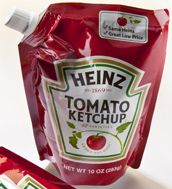

|
Source
More packaged-food makers turn to pouches By Emily Bryson York March 19, 2012 Reporting from Chicago— Packaged-food makers are thinking outside the bottle and can. More to the point, they're increasingly partial to pouches. Kitchen staples from Campbell Soup Co.and H.J. Heinz Co.will be joining other consumer products in pouches this year. The trend is being driven by savings on packaging and shipping costs as well as aesthetics — an upscale pouch sporting elaborate graphics offers a modernized look and premium appeal, marketers say. John Kalkowski, editorial director of Packaging Digest, said pouches also are becoming more prevalent because technology has improved, doubling average shelf life to two years from one. Manufacturers can cut packaging costs 10% to 15% by going to the pouch, Kalkowski said. Overall pouch use in consumer products, including shampoo and pet food, has increased 37% since 2007, according to market research firm Mintel Group Ltd., with particular growth in snack pouches. For Campbell, the move is part of a battle for credibility with millennials, those ages 18 to 34, who tend to associate its iconic red-and-white cans with Grandma's house. This summer, the Camden, N.J., company will launch Campbell's Go Soup, a premium line with trendy flavors such as coconut curry with chicken and shiitake mushrooms. Go Soup comes in an edgy, graphically intense pouch with funky fonts and pictures of young people making quirky faces, seeming to enjoy the soup. Informal notes at the bottom try to eliminate confusion about the product, such as "shiitake happens, but this soup is ready to eat." A company spokesman said Campbell has yet to set prices on the new soups. The soup giant is looking to turn its primary business around after years of volume declines. Although officials said Campbell's first goal is to support its iconic can, the company is looking to baby boomers' children as they're starting to set up households and making a big bet on pouches to catch their attention. "We want to fire some bullets, and if they become cannonballs, we'll put our money down," Campbell Chief Executive Denise Morrison said. "It's a different approach for us, but we're going to listen to consumers; we're going to develop the products that they want. But then they need to buy them." The company also will launch a line of skillet sauces in pouches this fall, designed to make dishes such as shrimp scampi or Thai green curry chicken easy when the right protein and starch are already on hand. Charles Villa, vice president of the consumer and customer insights department for Campbell's USA, said pouches have broad appeal to consumers, particularly those younger than 35. "They see the pouch as a very contemporary packaging alternative and they relate that packaging to a better quality experience coming from the food that's in," Villa said, adding that they expect "a better quality experience for the food," and even a fresher product. For Heinz, however, a flexible pouch is being used to introduce a smaller size of its namesake ketchup. With a squeezable pouch and a nozzle, the 10-ounce product will sell for 99 cents compared with $1.99 for a 20-ounce bottle. The typical shopper in a developed market such as the U.S., CEO William R. Johnson said, "is now intensely focused on value," adding that buying decisions are based more on price "and less about product design." In this environment, the world's largest ketchup company has been looking for ways to maintain dominance as families look for food bargains at discount retailers and even dollar stores. With the pouch's lower price, Heinz is hoping to give budget-minded families a reason to buy its product rather than a private-label offering. Johnson said the company is optimistic about the pouches, given evidence that U.S. shoppers are looking for smaller sizes, and the success Heinz has had with pouched sauces and other products including baby food in developing markets such as Russia, Costa Rica, Mexico and Brazil. Both Heinz and Campbell declined to comment on any savings associated with pouches. Although pouches have been prominent in Europe, Central and South America for five years or more, they're beginning to gain traction in the United States, which is notoriously slow in adapting to trends, said Lynn Dornblaser, director of innovation and insight at Mintel. In Europe, she said, consumers are accustomed to buying milk in pouches too. eayork@tribune.com |